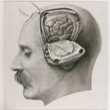Monday, 3 September 2012
The beginning of modern neurosurgery
 Probably the oldest form of neurosurgery is trepanation, which consisted in drilling a hole in the skull to allow evil spirits to escape from the brain. For example, scientists have found the skull of a young girl who was trepanned with a flint instrument in about 3 500 BCE. What is most remarkable are the scars suggesting that she survived this operation.
Probably the oldest form of neurosurgery is trepanation, which consisted in drilling a hole in the skull to allow evil spirits to escape from the brain. For example, scientists have found the skull of a young girl who was trepanned with a flint instrument in about 3 500 BCE. What is most remarkable are the scars suggesting that she survived this operation.
Modern neurosurgery did not really begin until the late 19th century, when surgeons opened the meninges to operate directly on the brain. But these first years were difficult ones: the survival rate for any surgical procedure that involved opening the skull was only 10%!
Then came American surgeon Harvey Cushing (1869-1939), now regarded as the father of modern neurosurgery. In the early 20th century, he developed a great many new techniques that increased the survival rate for neurosurgery spectacularly, to over 90%! (more…)
From the Simple to the Complex | Comments Closed







